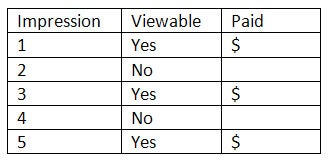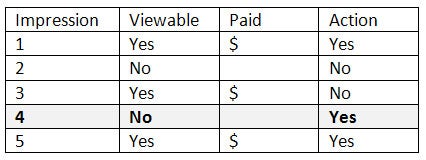 “Data Driven Thinking” is written by members of the media community and contains fresh ideas on the digital revolution in media.
“Data Driven Thinking” is written by members of the media community and contains fresh ideas on the digital revolution in media.
Today’s column is written by Adrian Tompsett, Vice President of Business Development at DataXu.
It’s been a busy couple of months for the emerging viewability metric.
Here’s a small sample of headlines:
- Ford is testing viewability partners
- BrightRoll adopts comScore’s viewability offering
- TripAdvisor says it will only charge for viewed impressions
- European media declares viewability standards are coming soon
- Ad Network Undertone promises viewability guarantees.
Many marketers are also jumping on the bandwagon to dictate that they only pay for viewable impressions. This appears to be an entirely rational move, right? If my ads are not seen by consumers, then I won’t pay for them. With this policy in place, my marketing spend by definition will be more effective. Or will it?
I’m going to make a provocative claim: You’re asking your media-delivery partners for the wrong thing.
This might sound odd coming from me. Earlier this year, I wrote an article in praise of incorporating viewability as one of the metrics to assess your media spend. That said, changing your approach to viewability without simultaneously addressing attribution will lead to bad ROI calculations, mistaken insights and, on top of that, it will create new margin opportunity for your media partners.
Don’t get me wrong: There’s little question that media sellers will be able to deliver exactly what these marketers are asking for, which is “guaranteed viewability.” That viewability will not, however, mean that marketers will improve the effectiveness of their digital media dollars, nor will they recognize that they’re inadvertently asking their media delivery partners for the wrong thing.
Let’s look at how your typical ad network would respond to this request. Today I charge my client a $2.00 CPM for the “quality” media they are purchasing. Once the marketer shines the light of viewability on this buy, she discovers that 40% of the impressions are served in-view. With this report in hand, the marketer walks in and says, “Ad network, I will only pay for viewable impressions.” But, Whac-A-Mole style, as we see one problem solved, another pops up to replace it.
How would the ad network respond?
With simple math.
The ad network responds with a proposal for “guaranteed viewability,” a campaign that will run at a $4.00 CPM, with the client only paying for those impressions validated as in-view. And therein lies the new arb opportunity. With some viewability experience and some minor campaign tweaks, an ad network can get that in-view percentage up – without too much difficulty – to, let’s say, 50% or 60%. With some major tweaks, they could boost that number even higher. The net result here would be that the ad network actually improves its margins, but the marketer would not actually gain improved efficiency or effectiveness for its marketing dollar, which is what drove the move toward viewability in the first place. In this scenario, viewability just becomes the new CPA, and one step forward drives the industry ten steps back.
The Simple View
Imagine five impressions measured against viewability. Under the new regime, the advertiser says it will only pay for impressions 1, 3 and 5.
Now factor in last-viewed attribution modeling. Sounds like a win: The media buyer is incented to find viewable impressions. The marketer gets better viewability.
You know that can’t be right. An impression that wasn’t viewed can’t impact consumer behavior, can’t cause a conversion, right? Right. Impression No. 4 was not viewed and you didn’t pay for it. Yet you gave that vendor attribution credit when calculating post-view CPA.
Then why would you give it credit for one?
A Better Approach
One reason viewability is so attractive is because it’s such a simple concept. For any new construct to hold up and get widely adopted in our space, it must be easily distilled and understood. We have seen many of the complex attribution vendors make some progress, but it is a slow and painful slog. In my opinion, changing attribution models is hard and isn’t going to happen any time soon. Conceptually, I’m on board with smarter attribution models, but I’m also painfully aware of today’s operational realities and the fundamental misalignment among industry players that is preventing widespread adoption.
Instead, let me propose a baby step that can help agencies and marketers better assess the mix of media sellers and technology platforms on their plan. Run your attribution model the same way you always have, but with a twist. Stop automatically crediting the last impression before the user converted. Why? Because that model incentivizes your media partners into a game of lower-funnel cookie-bombing that has been proven extremely effective at winning last-view attribution…and totally ineffective at delivering incrementality and real-world marketing effectiveness.
Instead, credit the partner who served the last viewable impression before the user converted.
I’m the first to admit that by no means is this a perfect attribution model. However, I do believe that the results of viewing campaign results through this lens will be incredibly illuminating. This perspective will separate the wheat from the chaff in your media plan, and will represent the first major step in the journey toward optimizing your digital marketing effectiveness.
This attribution filter changes the whole formula for how your media partners deliver value. In the old view-through game, better described as “last-served,” exploitation of the attribution model’s flaws is the winning formula. Victory in that game is driven by high frequency, low CPMs, tool-bar inventory, and a host of tried-and-true industry bad practices (e.g. “cookie-bombing”) that successfully place the last cookie into a user’s browser to win the attribution of a nonincremental conversion.
Victory in the new game will be about creating real, incremental value for the marketer. It’s time to stop talking about viewability as a standalone KPI or the newest performance-billing model, and instead use it as a new filter to make each digital marketing dollar much, much more effective.
Follow Adrian Tompsett (@atompsett) and AdExchanger (@adexchanger) on Twitter.















